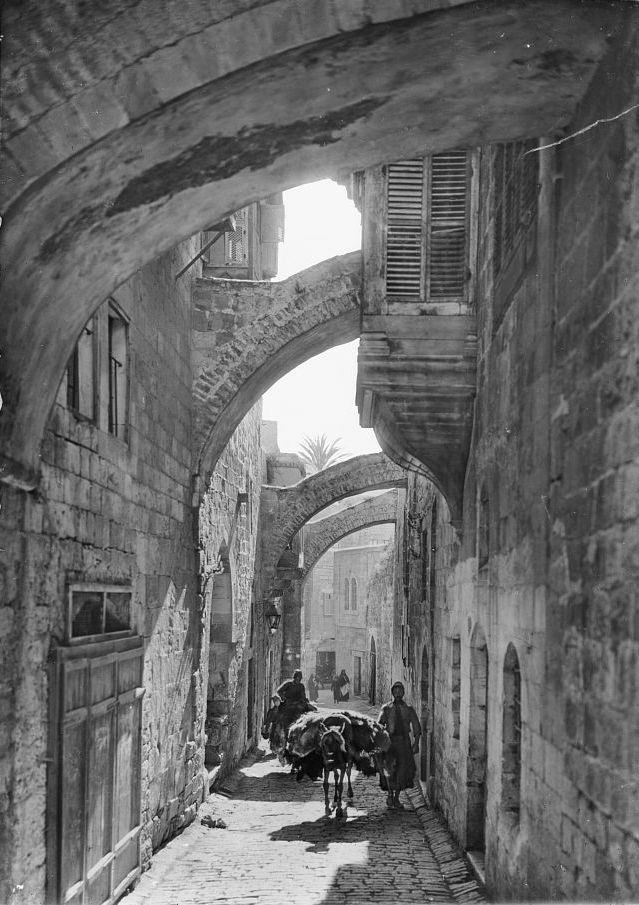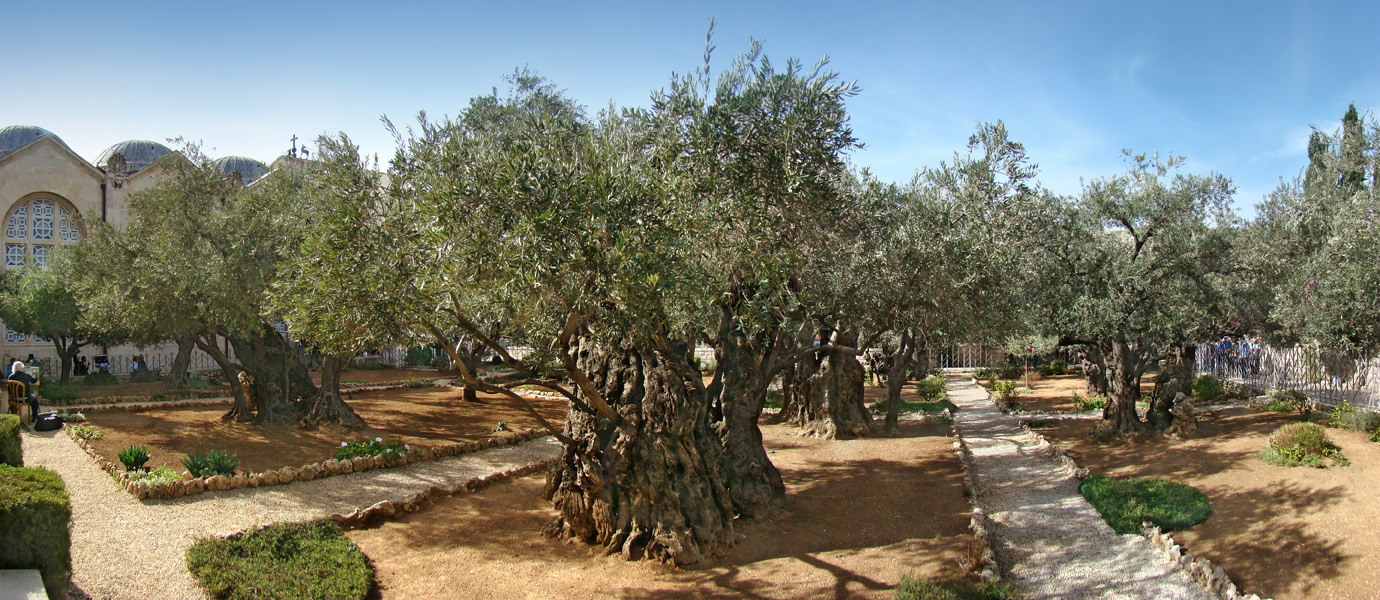|
Via Dolorosa
The (Latin for 'Sorrowful Way', often translated 'Way of Suffering'; ; ) is a processional route in the Old City of Jerusalem. It represents the path that Jesus took, forced by the Roman soldiers, on the way to his crucifixion. The winding route from the former Antonia Fortress to the Church of the Holy Sepulchre—a distance of about —is a celebrated place of Christian pilgrimage. The current route has been established since the 18th century, replacing various earlier versions.Jerome Murphy-O'Connor, ''The Holy Land'', (2008), p. 37 It is today marked by 14 Stations of the Cross, nine of which are outside, in the streets, with the remaining five stations being currently inside the Church of the Holy Sepulchre. History The is not one street, but a route consisting of segments of several streets. One of the main segments is the modern remnant of one of the two main east-west routes () through the Roman city of Aelia Capitolina, as built by Hadrian. Standard Roman city desi ... [...More Info...] [...Related Items...] OR: [Wikipedia] [Google] [Baidu] |
City Block
A city block, residential block, urban block, or simply block is a central element of urban planning and urban design. In a city with a grid system, the block is the smallest group of buildings that is surrounded by streets. City blocks are the space for buildings within the street pattern of a city, and form the basic unit of a city's urban fabric. City blocks may be subdivided into any number of smaller land lots usually in private ownership, though in some cases, it may be other forms of tenure. City blocks are usually built-up to varying degrees and thus form the physical containers, or "streetwalls," of public spaces. Most cities are composed of a greater or lesser variety of sizes and shapes of an urban block. For example, many pre-industrial cores of cities in Europe, Asia, and the Middle East tend to have irregularly shaped street patterns and urban blocks, while cities based on grids have much more regular arrangements. By extension, the word "block" is an important in ... [...More Info...] [...Related Items...] OR: [Wikipedia] [Google] [Baidu] |
Templum Domini
The ''Templum Domini'' (Vulgate translation of Hebrew: "Temple of the Lord") was the name attributed by the Crusaders to the Dome of the Rock in Jerusalem. It became an important symbol of Jerusalem, depicted on coins minted under the Catholic Christian Kingdom of Jerusalem. History The Dome of the Rock was erected in the late 7th century under the 5th Umayyad Caliph Abd al-Malik ibn Marwan at the site of the former Jewish Second Temple (or possibly added to an existing Byzantine building dating to the reign of Heraclius, 610–641). After the capture of Jerusalem in the First Crusade (1099), the Dome of the Rock was given into the care of Augustinian Canons Regular. At first, the rock around which the shrine had been built was left uncovered and the canons placed an altar on it. Later the rock was covered with white marble and an altar choir constructed upon it, a work that likely was completed only in 1140. In 1138 the Templum Domini was raised to the status of an abbey ... [...More Info...] [...Related Items...] OR: [Wikipedia] [Google] [Baidu] |
Kingdom Of Jerusalem
The Kingdom of Jerusalem, also known as the Crusader Kingdom, was one of the Crusader states established in the Levant immediately after the First Crusade. It lasted for almost two hundred years, from the accession of Godfrey of Bouillon in 1099 until the Siege of Acre (1291), fall of Acre in 1291. Its history is divided into two periods with a brief interruption in its existence, beginning with its collapse after the Siege of Jerusalem (1187), siege of Jerusalem in 1187 and its restoration after the Third Crusade in 1192. The original Kingdom of Jerusalem lasted from 1099 to 1187 before being almost entirely overrun by the Ayyubid dynasty, Ayyubid Sultanate under Saladin. Following the Third Crusade, it was re-established in Acre, Israel, Acre in 1192. The re-established state is commonly known as the "Second Kingdom of Jerusalem" or, alternatively, as the "Kingdom of Acre" after its new capital city. Acre remained the capital for the rest of its existence, even during the tw ... [...More Info...] [...Related Items...] OR: [Wikipedia] [Google] [Baidu] |
East-West Schism
East West (or East and West) may refer to: *East–West dichotomy, the contrast between Eastern and Western society or culture Arts and entertainment Books, journals and magazines *'' East, West'', an anthology of short stories written by Salman Rushdie * ''East and West'' (book), a 1998 book by Christopher Patten, the last British governor of Hong Kong *'' Philosophy East and West'', an international, interdisciplinary academic journal *''East and West'', a quarterly English-language journal published 1950 to 2009 by the Istituto Italiano per l'Africa e l'Oriente * '' Ost und West'', a German magazine Film, TV and theatre * '' East and West (film)'', a 1923 Austrian silent film *'' East/West'' (also known as ''Est-Ouest''), a 1999 film by Régis Wargnier * East West Players, an Asian American theatre organization *'' East West 101'', an Australian television drama series *'' Purab Aur Paschim'' (East and West), a 1970 Bollywood movie Music * ''East-West'' (The Butterfield Bl ... [...More Info...] [...Related Items...] OR: [Wikipedia] [Google] [Baidu] |
Praetorium
The Latin term ''praetorium'' (also and ) originally identified the tent of a general within a Roman '' castrum'' (encampment), and derived from the title praetor, which identified a Roman magistrate.Smith, William. Dictionary of Greek and Roman Antiquities, 2 ed., s.v. "Praetorium". London: John Murray, 1872. Originally, praetor ("leader") was the title of the ranking civil servant in the Roman Republic, but later identified a rank of office below the rank of consul. The war-council meetings held in the tent of a general gave administrative and juridical meanings to the term ''praetorium'', a usage continued into the Byzantine Empire, where the term identified the residence of the governor of a city. The term also designated the headquarters of the Roman emperor, as well as the camp of the Praetorian Guard stationed in Rome. Description Due to the number of uses for the word ''praetorium'', it is difficult to describe; a ''praetorium'' could be a large building, a permane ... [...More Info...] [...Related Items...] OR: [Wikipedia] [Google] [Baidu] |
Holy Wisdom
Holy Wisdom (, ) is a concept in Christian theology. Christian theology received the Old Testament personification of Wisdom (Hebrew ''Chokmah'') as well as the concept of Wisdom (''Sophia'') from Greek philosophy, especially Platonism. In Christology, Christ the Logos as God the Son was identified with Divine Wisdom from earliest times. There has also been a minority position which identified Wisdom with the Holy Spirit instead. Furthermore, in mystical interpretations forwarded in Russian Orthodoxy, known as Sophiology, Holy Wisdom as a feminine principle came to be identified with the Theotokos (Mother of God) rather than with Christ himself. Similar interpretations were proposed in feminist theology as part of the " God and Gender" debate in the 1990s. Old Testament In the Septuagint, the Greek noun ''sophia'' is the translation of Hebrew "wisdom". Wisdom is a central topic in the "sapiential" books, i.e. Proverbs, Psalms, Song of Songs, Ecclesiastes, Book of Wisdo ... [...More Info...] [...Related Items...] OR: [Wikipedia] [Google] [Baidu] |
Mount Zion
Mount Zion (, ''Har Ṣīyyōn''; , ''Jabal Sahyoun'') is a hill in Jerusalem, located just outside the walls of the Old City (Jerusalem), Old City to the south. The term Mount Zion has been used in the Hebrew Bible first for the City of David (archaeological site), City of David (, ; , ) and later for the Temple Mount, but its meaning has shifted and it is now used as the name of ancient Jerusalem's Western Hill. In a wider sense, the term Zion is also used for the entire Land of Israel. Etymology The etymology of the word ''Zion'' is uncertain. Mentioned in the Bible in the Book of Samuel (2 Samuel 5:7) as the name of the Jebusite fortress conquered by King David, its origin likely predates the Israelites. If Semitic languages, Semitic, it may be associated with the Hebrew root ''ṣiyyôn'' ("castle"). Though not spoken in Jerusalem until 1,700 years later, the name is similar in Arabic language, Arabic and may be connected to the root ''ṣiyya'' ("dry land") or the Arabic ' ... [...More Info...] [...Related Items...] OR: [Wikipedia] [Google] [Baidu] |
House Of Caiaphas, Mount Zion
The Monastery (Convent) of Saint Saviour () is a monastery of the Armenian Church in Jerusalem on Mount Zion. Outside of the Armenian Quarter, Old City, it is south of the Zion Gate. It includes two church buildings, the newer of which is unfinished. Traditions The house of Caiaphas, the Jewish high priest at the time of Jesus' death, is believed to be on the site. However, some Christians conflated Caiaphas' house with the house of Annas (Annas was Caiaphas' father-in-law and a former high priest). It is also called ''Dair Habs al-Masih'' ( , ) in Arabic, since it is one of the supposed locations of the prison of Christ, where he was held after the Sanhedrin trial. Because the gospels themselves disagree whether Jesus was brought to Annas' or Caiaphas' house/court, the Armenian Church of the Holy Archangels ("house of Annas") also has a prison of Christ. A stone relocated from the entrance of the tomb of Christ is also believed to be over or under the altar at the old ... [...More Info...] [...Related Items...] OR: [Wikipedia] [Google] [Baidu] |
Lions' Gate
Lions' Gate (, ), also St Stephen's Gate, is one of the seven open Gates of the Old City of Jerusalem. It leads into the Muslim Quarter of the Old City. History The start of the traditional Christian observance of the last walk of Jesus from prison to crucifixion, the Via Dolorosa, begins at the Lions' Gate, called St Stephen's Gate by Christians. Carved into the wall above the gate are four lions, two on the left and two on the right. Suleiman the Magnificent had the carvings made to celebrate the Ottoman defeat of the Mamluks in 1517. Legend has it that Suleiman's predecessor Selim I dreamed of lions that were going to eat him because of his plans to level the city. He was spared only after promising to protect the city by building a wall around it. This led to the lion becoming the heraldic symbol of Jerusalem. Murphy-O'Connor, Jerome, ''The Holy Land: an Oxford archaeological guide from earliest times to 1700'', 2008, p. 21, Historian Moshe Sharon notes the similarity of ... [...More Info...] [...Related Items...] OR: [Wikipedia] [Google] [Baidu] |
Gethsemane
Gethsemane ( ) is a garden at the foot of the Mount of Olives in East Jerusalem, where, according to the four Gospels of the New Testament, Jesus Christ underwent the Agony in the Garden and was arrested before his crucifixion. The garden is a place of great resonance in Christianity. There are several small olive groves in church property, all adjacent to each other and identified with biblical Gethsemane. Etymology ''Gethsemane'' appears in the Greek original of the Gospel of Matthew and the Gospel of Mark as (). The name is derived from the Aramaic (), or Hebrew () meaning ' oil press'. Matthew 26:36 and Mark 14:32 call it (), meaning a place or estate. The Gospel of John says Jesus entered a garden (, ) with his disciples. Location According to the New Testament the garden was a place that Jesus and his disciples customarily visited, which allowed Judas Iscariot to find him on the night Jesus was arrested. There are four locations, all of them at or near the west ... [...More Info...] [...Related Items...] OR: [Wikipedia] [Google] [Baidu] |




